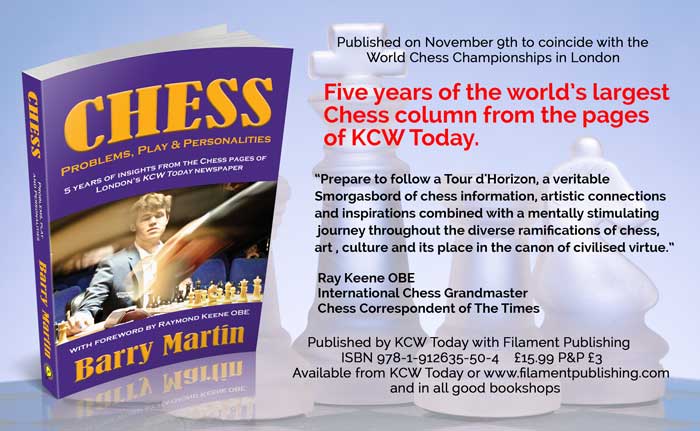Writes Raymond Keene OBE – International Chess Correspondent for The Times;
“All chess players are artists , but not all artists are chess players! ”
Thus spake Marcel Duchamp, the most influential artist of the twentieth century, outranking even Picasso and Dali in the scope of his effect on subsequent generations of aspiring Raphaels, Titians, Leonardos and Michelangelos. In popular estimation, Duchamp himself largely abandoned art for chess after completion of his Large Glass, though initiates are fully aware that he continued to produce art throughout his career, though art with a heavy inclination towards the intellectual rigour and geometric aesthetic of chess. Hence Etant Donnees contains a piece of chequered Lino , representing a chessboard, concealed underneath the centrally placed nude body….Duchamp’s game of chess against the nude model Eve Babitz has achieved iconic status, while Duchamp’s very last work, Reunion, from 1968, featured a game of chess against avant grade composer John Cage, where every move on the board set off a musical tone!
Duchamp’s love of chess was infectious. Not wishing to be left behind in the mental arms race to demonstrate the altitude of their intellectual credentials , no less a cohort of twentieth century artistic greats, than Ernst, Picabia, Man Ray, Calder ….all jumped on the brain wagon to depict chess motifs in their work. At an exhibition devoted to Dada and Surrealism at the Pompidou Centre in Paris ( check date) the undoubted star was Duchamp himself, but so extensive were the homages of his epigoni, that the Exhibition metamorphosed into a display of chess art rather than Dadart. To top it all, the major constantly relooping filmic image was that of Entr’acte , where Duchamp plays chess against Andre Breton on the roofs of Paris. The difference was that Duchamp was not merely a utiliser of chess images, but also a Master of the game itself. He had tied at chess with a world championship candidate and represented France in the chess Olympiad, along with world champion of the day, Alexander Alekhine.
The banner of the chess expert artist is now held aloft by the author of this anthology of columns from KCW , Barry Martin, who not only has the distinction of writing the world’s largest chess column each month, but has also gained a world chess ranking. In Duchamp’s time , such ratings had not been invented, so Barry is the only artist on the planet who has achieved this accolade.
Barry’s works have been exhibited at major outlets such as London’s Tate Gallery, The National Portrait Gallery, The Victoria and Albert Museum , Simpsons in The Strand , the traditional home of British chess, and at mind sports Olympiads and world chess championships , where he has been official artist in residence.
The theme of chess, of course, is a prominent thread throughout his oeuvre, ranging from the biodegradable potato chess set, through portraits distributed by The Times of Garry Kasparov and Nigel Short, as well as an exclusive photographic portfolio of the world’s greats, from which the illustration of world champion Magnus Carlsen, which adorns the front cover of this book, has been selected. On the back cover, we see Barry in play against a vital link to the chess art traditions of the past, his opponent being Marcel Duchamp’s widow, Mme Teeny Duchamp herself. Teeny, of course , was a close spectator at the John Cage Reunion manifestation of 1968 at Toronto, and therefore an essential part of the action and of the history of chess art , a tradition which extends right back to the Ancient Greek vase decorator Exekias who depicted Ajax and Achilles facing off over a board game during the Siege of Troy.
There is one further arena in which Barry scores heavily, and that is in the dimension of reviving the mystique and wonder of chess. It is all too easy for those engaged in the rough and tumble of chess combat to overlook the mystery and infinite aesthetic profundity of its intellectual and iconic ethos. One example stands out…Barry has encountered many of the greats in person and across the board. After one game during the 1993 world championship against Nigel Short on stage in the Savoy Theatre, Grandmaster Yuri Averbakh, former Soviet Champion and arbiter in the Kasparov v Short world championship, congratulated Barry on his stout resistance against the then world number two. Barry’s reaction was to point out how the pawn structure triumvirate resembled a Patte d’oie an artistic formation from Le Notre’s 17th century French garden design! And talking of pawns, Barry’s insights into the relationship between Staunton pattern pieces, pawns and Masonic Symbology are worthy of a new Dan Brown novel.
So, in this book, prepare to follow a Tour d’Horizon, a veritable Smorgasbord of chess information, artistic connections and inspirations combined with a mentally stimulating journey throughout the diverse ramifications of chess, art , culture and its place in the canon of civilised virtue.
Ray Keene OBE
International Chess Grandmaster
Chess Correspondent of The Times
Available for pre-order shortly
ISBN 978-1-912635-50-4 £15.99 P&P £3 Available from KCW Today or www.filamentpublishing.com and in all good bookshops
